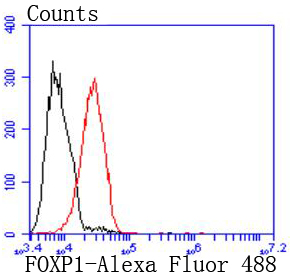Product Detail
Product NameFOXP1 Rabbit mAb
Clone No.JF1017
Host SpeciesRecombinant Rabbit
Clonality Monoclonal
PurificationProA affinity purified
ApplicationsWB, IHC, FC
Species ReactivityHu, Ms, Rt
Immunogen Descrecombinant protein
ConjugateUnconjugated
Other Names12CC4 antibody FLJ23741 antibody Fork head related protein like B antibody Forkhead box P1 antibody Forkhead box protein P1 antibody FOX P1 antibody FOXP 1 antibody foxp1 antibody FOXP1_HUMAN antibody Glutamine rich factor 1 antibody hFKH1B antibody HSPC215 antibody MGC12942 antibody MGC88572 antibody MGC99551 antibody QRF 1 antibody QRF1 antibody
Accession NoSwiss-Prot#:Q9H334
Uniprot
Q9H334
Gene ID
27086;
Calculated MW77/75 kDa
Formulation1*TBS (pH7.4), 1%BSA, 40%Glycerol. Preservative: 0.05% Sodium Azide.
StorageStore at -20˚C
Application Details
WB: 1:1,000-5,000
IHC: 1:50-1:200
FC: 1:50-1:100
Western blot analysis of FOXP1 on different lysates using anti-FOXP1 antibody at 1/1,000 dilution. Positive control: Lane 1: Hela Lane 2: Jurkat Lane 3: MCF-7
Immunohistochemical analysis of paraffin-embedded human colon cancer tissue using anti-FOXP1 antibody. Counter stained with hematoxylin.
Immunohistochemical analysis of paraffin-embedded human breast carcinoma tissue using anti-FOXP1 antibody. Counter stained with hematoxylin.
Flow cytometric analysis of MCF-7 cells with FOXP1 antibody at 1/50 dilution (red) compared with an unlabelled control (cells without incubation with primary antibody; black). Alexa Fluor 488-conjugated goat anti rabbit IgG was used as the secondary antibody
The FOX family of transcription factors is a large group of proteins that share a common DNA binding domain termed a winged-helix or forkhead domain. During early development, FOXP1 and FOXP2 are expressed abundantly in the lung with lower levels of expression in neural, intestinal and cardiovascular tissues, where they act as transcription repressors. FOXP1 is widely expressed in adult tissues, while neoplastic cells often exhibit a dramatic change in expression level or localization of FOXP1. The gene encoding human FOXP1 maps to chromosome 3p14.1. The gene encoding human FOXP2 maps to chromosome 7q31. The gene encoding FOXP3, a third member of this family, maps to chromosome Xp11.23-Xq13.3. Mutations in this gene cause IPEX, a fatal, X-linked inherited disorder characterized by immune dysregulation. The FOXP3 protein, also known as scurfin, is essential for normal immune homeostasis. Specifically, FOXP3 represses transcription through a DNA binding forkhead domain, thereby regulating T-cell activation.
If you have published an article using product 49358, please notify us so that we can cite your literature.






 Yes
Yes



